#Douglas Aircraft Company
Text

As the Sky Chiefs pass in the night.
#vintage illustration#twa#trans world airlines#vintage travel#airliners#airlines#vintage air travel#twa douglas skyliner#douglas skyliner#sky chief#douglas dc-2 skyliner#dc-2#skyliner#douglas dc-2#douglas aircraft company
25 notes
·
View notes
Text
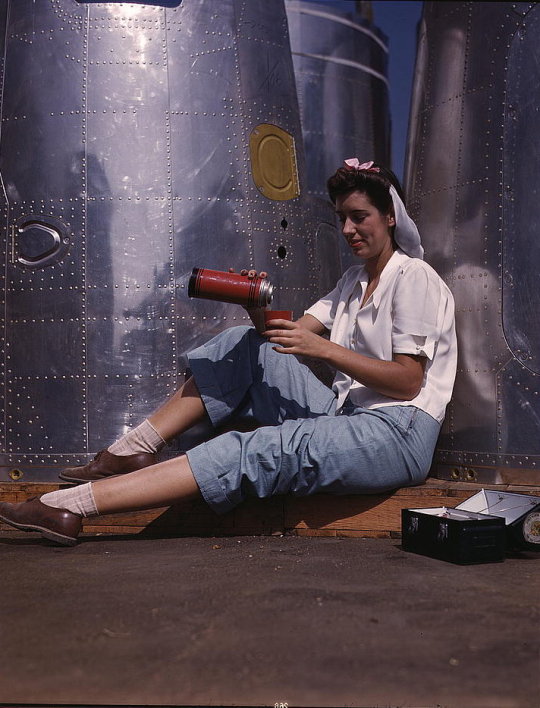
Ouvrière américaine en pause déjeuner – Douglas Aircraft Company – Long Beach – Californie – Etats-Unis – Octobre 1942
Photographe : Alfred Palmer
©United States Library of Congress - LC-DIG-fsac-1a35343
#WWII#home front#ouvriers#ouvrières#workers#douglas aircraft company#long beach#californie#california#états-unis#usa#10/1942#1942
12 notes
·
View notes
Photo
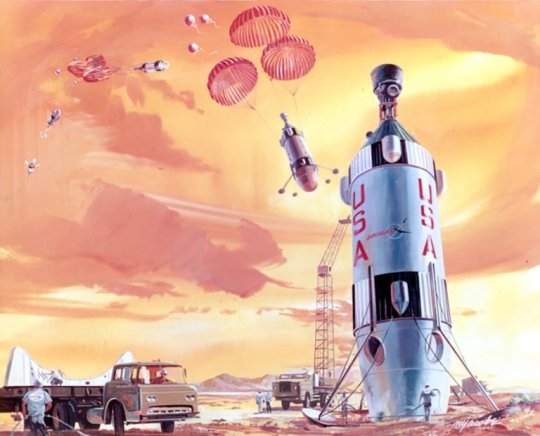
Saturn Upper Stage Booster Recovery Concepts by Douglas Aircraft Company (Philip Bono)
#Sci-Fi#Mecha#Concept Art#Saturn Rocket#Retrofuturism#Douglas Aircraft Company#Philip Bono#Spaceship#Booster
37 notes
·
View notes
Video
Philip Bono Collection Image by SDASM Archives
Via Flickr:
PictionID:46907719 - Catalog:Bono_0027 - Title:S-IVB DAC 20080 - Filename:Bono_0027.tif - Philip Bono was a renowned space engineer who was probably 30 years before his time. He was born in Brooklyn, NY on January 13, 1921. He graduated from the University of Southern California in 1947 with a B.E. degree in mechanical engineering, and served three years in the U.S. Naval Reserves. After graduation in 1947, Mr. Bono worked as a research and systems analyst for North American Aviation. His first "tour" with Douglas Aircraft Company was from 1949 to 1951, doing structural layout and detail design. From 1951 to 1960, he worked primarily in structures design at Boeing. - ---Please Tag these images so that the information can be permanently stored with the digital file.---R---Repository: San Diego Air and Space Museum
#Neil Jacobe#S-IVB stage#Douglas Aircraft Company#artist concept#artist rendering#artist’s concept#artist’s rendering#flickr#S-IVB#concept#recovery#multi use#rocket
3 notes
·
View notes
Text
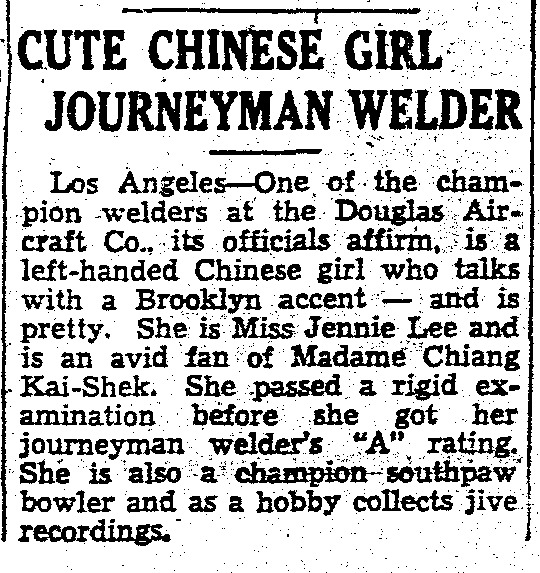
"CUTE CHINESE GİRL JOURNEYMAN WELDER," Toronto Star. March 26, 1943. Page 2.
-----
Los Angeles - One of the champion welders at the Douglas Aircraft Co., its officials affirm, is a left-handed Chinese girl who talks with a Brooklyn accent - and is pretty. She is Miss Jennie Lee and is an avid fan of Madame Chiang Kai-Shek. She passed a rigid examination before she got her journeyman welder's "A" rating. She is also a champion-southpaw bowler and as a hobby collects jive recordings.
#los angeles#douglas aircraft company#welders#aircraft factory#brooklyn#chinese americans#cute girl#journeyman welder#human interest story#war workers#world war ii
0 notes
Text
Icarus

To improve is to change; to be perfect is to change often.
Winston Churchill
Ledger books compelled American Airlines to diversify its business model and set greater store in passengers with the advent of the Air Mail Act of 1934. The pivot was an existential one since this market of travellers was no longer peripheral and the fiscal sustenance of airmail grew modest by comparison. Whereas in 1931 roughly 85 percent of revenue was under the auspices of CAM routes and 15 percent from passengers by 1935 a near parity of earnings prompted a transition towards society’s itinerants (Airports Council 2019). Three years later the operating revenue from passengers exceeded airmail by 45 percent. Airline route mileage manifestly rose then following this artifact of legislation. The red-letter reason behind why the industry came to be turbocharged gives vent to the incentive structure previously fostered under the Air Mail Act of 1930. In the most laconic of descriptions the former policy rewarded size. The larger the plane the better. Heretofore the remuneration of airmail hinged on weight but now it was instead premised on payload dimensions. To exploit this new parameter it was incumbent on airlines to maximize their cubic footage if weight was to be given short shrift. Space was the new currency and airlines began to adopt larger aircraft for the dual revenue stream of mail and passengers.


At the outset American Airlines might have been a mail carrier with a few seats to spare but the incentivization of space heralded a Eureka moment turning the company into a bona fide gateway to the skies for passengers. The Air Mail Act of 1930 re-engineered the DNA of aviation overnight with the implicit premium on these patrons. This renaissance changed the optics of air travel from pragmatism to comfort akin to the experience atop the deck of an ocean liner. The industry no longer saw itself tethered to the transport sector as it began to interface with hospitality and tourism. Later in the postlapsarian world where an unholy alliance of business and government culminated in the Air Mail Act of 1934 American Airlines would liaise with the Douglas Aircraft Company to offset the new cutbacks. The airline harboured a desire to begin an overnight service for transcontinental flights upon an aircraft that was fast and spacious. Douglas was cowed into producing such a machine bejewelled with a dormitory for onboard passengers to sleep since the commission came from its largest buyer (Leary 1992). The DC-3 seating 21 to 32 souls would be based on its DC-2 sibling. Endowed with a cruising speed of 180mph the plane generated enough income bereft of any airmail revenue which itself began to free fall.
The newer industrial policy proved to be a clarion call for such innovation with the impulse to maximize earnings from passengers. From the ateliers of Douglas emerged a frontier technology so profound it redefined flight from a luxury into a utility. The socioeconomics was indelibly a function of the plane’s engineering. A range of 1,500 miles coupled with a lower cost per mile calculus and punctuated by larger capacity would in concert laud the aircraft as a runaway success. These metrics eclipsed the nearest competitor of Boeing’s 247 which could scarcely travel 750 miles. Douglas’ flying salon was leagues apart from other designs so that by 1939 over 90 percent of the world’s airline traffic boarded this skyward locomotive (Smithsonian Institution 2020). This prodigious figure and the DC-3 itself were the poster child of the Air Mail Acts. Claustrophobia may have once been the bête noire of air travel but it became an anachronism in this new age of aviation with the DC-3 as its protagonist. American Airlines capitalized on this aircraft’s magic within the brief interstice between the new Air Mail Act and 1938 when passenger miles rose 150 percent (Leary 1992: 39). From the company’s inception it had lamented a burn rate of $758k per annum until this first positive cash flow upon flying the DC-3 for just a short two years.

The wisdom of remunerating capacity over weight was the original muse for the take-off of airlines and aircraft. Once the impetus of payload factored into the equation and airmail revenue subsequently dried up a race for innovation saw Douglas’ form factor adopted by the firmament of aviation. Passenger service would come to epitomize the Cinderella of airlines as it was no longer subordinated to airmail. The scale economies wrought by the Douglas DC-3 engendered this epiphenomenon as the greater number of passengers minimized operating costs. In pithier language it meant more people and cargo could be flown for less money at 27 cents per ton-mile (Isard 1945). Dramatic reductions in expenses were leaps and bounds ahead of rivals which went on to vouchsafe the latitude for curbing airfare. If the Air Mail Act of 1934 sought to democratize the skies then the DC-3 prosecuted the mission. Even the aircraft’s rationalization of fuel and range saw fewer landing fees and less layovers that reduced overhead by circumventing ground crews and their wages. The fiscal advantages of counting this plane amongst a fleet spoke to why it conquered the skies in short order. American Airlines’ own alacrity of procurement in droves would be what fortified its competitive advantage over marketshare.


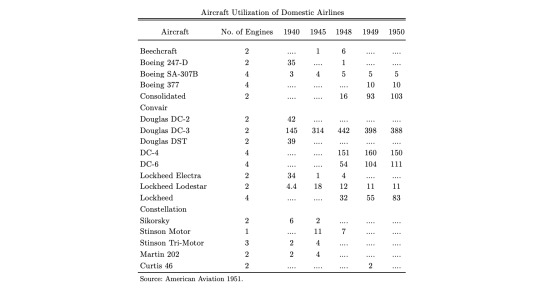
So the seesaw of industrial policy nourished commercial aviation by the paternalism of government until airlines and manufacturers had matured enough to optimize their revenue streams. By the time the proverbial noose of the Great Depression tightened around airmail contracts companies had already outgrown their dependency. Leaner earnings decoupled the industry from government as the former embraced passenger service to fill the void. In 1934 airlines flew a meagre 475k passengers but by 1940 this number soared over 146 percent. The economic imperatives of the contraction in the business cycle abreast of the sunk costs in payload-friendly aircraft found opportunity in whisking the middle class away to faraway destinations. The fanfare around airmail had begun to give way from its heyday as its viability waned which the Air Mail Act of 1934 symbolized. The spirit to defy gravity from commoners would instead be where airlines and manufacturers rediscovered their identity. Fleet expansions together with the proliferation of routes were obvious harbingers of this renewed focus on arousing the wanderlust of consumers. The planes themselves lent credence to this divergence bespoken by their plush interiors, berths and in-flight dining. The gimmicks knew no bounds in seducing passengers.
0 notes
Text

Amanda Smith, an African American woman employed in the Long Beach Plan of the Douglas Aircraft Company, standing on a ladder and holding a pair of pliers up to an airplane part
198 notes
·
View notes
Text
Boeing, Spirit and Jetblue, a monopoly horror-story

Catch me in Miami! I'll be at Books and Books in Coral Gables TONIGHT (Jan 22) at 8PM. Berliners: Otherland has added a second date (Jan 28) for my book-talk after the first one sold out - book now!

Last week, William Young, an 82 year old federal judge appointed by Ronald Reagan, blocked the merger of Spirit Airlines and Jetblue. It was a seismic event:
https://storage.courtlistener.com/recap/gov.uscourts.mad.254267/gov.uscourts.mad.254267.461.0_6.pdf
Seismic because the judge's opinion is full of rhetoric associated with the surging antitrust revival, sneeringly dismissed by corporate apologists as "hipster antitrust." Young called America's airlines and "oligopoly," a situation he blamed on out-of-control mergers. As Matt Stoller writes, this is the first airline merger to be blocked by the DOJ and DOT since deregulation in 1978:
https://www.thebignewsletter.com/p/antitrust-enforcers-block-the-jetblue
The judge wasn't shy about why he was reviving a pre-Jimmy Carter theory of antitrust: "[the merger] does violence to the core principle of antitrust law, 'to protect] markets –- and its market participants — from anticompetitive harm."
The legal arguments the judge advances are fascinating and worthy of study:
https://twitter.com/johnmarknewman/status/1747343447227519122
But what really caught my eye was David Dayen's American Prospect article about the judge's commentary on the state of the aviation industry:
https://prospect.org/infrastructure/transportation/01-19-2024-how-boeing-ruined-the-jetblue-spirit-merger/
Why, after all, have Spirit and Jetblue been so ardent in pursuing mergers? Jetblue has had two failed merger attempts with Virgin, and this is the third time they've failed in an attempt to merge with Spirit. Spirit, meanwhile, just lost a bid to merge with Frontier. Why are these two airlines so obsessed with combining with each other or any other airline that will have them?
As Dayen explains, it's because US aviation has been consumed by monopoly, hollowed out to the point of near collapse, thanks to neoliberal policies at every part of the aviation supply-chain. For one thing, there's just not enough pilots, nor enough air-traffic controllers (recall that Reagan's first major act in office was to destroy the air traffic controller's union).
But even more importantly, there are no more planes. Boeing's waitlist for airplane delivery stretches to 2029. And Boeing is about to deliver a lot fewer planes, thanks to its disastrous corner-cutting, which grounded a vast global fleet of 737 Max aircraft (again):
https://prospect.org/infrastructure/transportation/2024-01-09-boeing-737-max-financial-mindset/
The 737 disaster(s) epitomize the problems of inbred, merger-obsessed capitalism. As Luke Goldstein wrote, the rampant defects in Boeing's products can be traced to the decision to approve Boeing's 1997 merger with McDonnell-Douglas, a company helmed by Jack Welch proteges, notorious for cost-cutting at the expense of reliability:
https://prospect.org/infrastructure/transportation/2024-01-09-boeing-737-max-financial-mindset/
Boeing veterans describe the merger as the victory of the bean-counters, which led to a company that chases short-term profits over safety and even the viability of its business:
https://www.airliners.net/forum/viewtopic.php?t=213075
After all, the merger turned Boeing into the single largest exporter in America, a company far too big to fail, teeing up tens of billions from Uncle Sucker, who also account for 40% of Boeing's income:
https://www.thebignewsletter.com/p/its-time-to-nationalize-and-then
The US government is full of ex-Boeing execs, just as Boeing's executive row is full of ex-US federal aviation regulators. Bill Clinton's administration oversaw the creation of Boeing's monopoly in the 1990s, but it was the GOP that rescued Boeing the first time the 737 Maxes started dropping out of the sky.
Boeing's biggest competitor is the state-owned Airbus, a joint venture whose major partners are the governments of France, Spain and Germany – governments that are at least theoretically capable of thinking about the public good, not short-term profits. Boeing's largest equity stakes are held by the Vanguard Group, Vanguard Group subfiler, Newport Trust Company, and State Street Corporation:
https://prospect.org/blogs-and-newsletters/tap/2024-01-18-airbus-advantage/
As Matt Stoller says, America has an airline that the public bails out, protects, and subsidizes but has no say over. Boeing has all the costs of public ownership and none of the advantages. It's the epitome of privatized gains and socialized losses.
This is Reagan's other legacy, besides the disastrous shortage of air-traffic controllers. The religious belief in deregulation – especially deregulation of antitrust enforcement – leads to a deregulated market. It leads to a market that is regulated by monopolists who secretly deliberate, behind closed board-room doors, and are accountable only to their shareholders. These private regulators are unlike government regulators, who are at least nominally bound by obligations to transparency and public accountability. But they share on thing in common with those public regulators: when they fuck up, the public has to pay for their mistakes.
It's a good thing Boeing's executives are too big to fail, because they fail constantly. Boeing execs who are warned by subcontractors of dangerous defects in their planes order those subcontractors to lie, or lose their contracts:
https://www.levernews.com/boeing-supplier-ignored-warnings-of-excessive-amount-of-defects-former-employees-allege/
As a result of Boeing's mismanagement, America's only aircraft supplier steadily has lost ground to Airbus, which today enjoys a 2:1 advantage over Boeing. But it's not just Boeing that's the weak link aviation. US aviation is a chain entirely composed of weak links.
Take jet engines: Pratt & Whitney are Spirit's major engine supplier, but these engines suck as much as Boeing's fuselages. Much of Spirit's fleet is chronically grounded because the engines don't run. The reason Spirit buys its engines from those loveable goofballs at Pratt & Whitney? The Big Four airlines have bought all the engines for sale from other suppliers, leaving smaller airlines to buy their engines from fat-fingered incompetents.
This is why – as Dayen notes – smaller US airlines are so horny for intermarriage. They can't grow by adding routes, because there are no pilots. Even if they could get pilots, there'd be no slots because there are no air traffic controllers. But even if they could get pilots and slots, there are no planes, because Boeing sucks and Airbus can't make planes fast enough to supply the airlines that don't trust Boeing. And even if they could get aircraft, there are no engines because the Big Four aviation cartel cornered the market on working jet engines.
Part of Jetblue and Spirit's pitch was that they hand off the routes that they'd cut after their merger to other small airlines, like Frontier and Allegiant. But Frontier and Allegiant can't service those routes: they don't have pilots, slots, planes or engines.
Spirit hasn't been profitable since 2019 and is sitting on $4b in debt. Jetblue was proposing to finance its acquisition with another $3.5b in debt. The resulting airline could only be profitable by sharply cutting routes and massively raising prices, cutting 6.1m seats/year. With a debt:capital ratio of 111%, the company would have no slack and would need a bailout any time anything went wrong. Not coincidentally, the Big Four airlines also have debt:capital ratios of about 100-120%, and they do get bailouts ever time anything goes wrong.
As William McGee reminds us, it's been 14 years since anyone's started a new US airline:
https://twitter.com/WilliamJMcGee/status/1747363491445375072
US aviation is deeply cursed. But Boeing's self-disassembling aircraft show us why we can't fix it by allowing mergers: private monopolies, shorn of the discipline of competition and regulation, are extraction machines that turn viable businesses into debt-wracked zombies.
This is a subject that's beautifully illustrated in Dayen's 2020 book Monopolized, in the chapter on health care:
https://pluralistic.net/2021/01/29/fractal-bullshit/#dayenu
The US health care system has been in trouble for a long time, but the current nightmare starts with the deregulation of pharma. Pharma companies interbred with one another in a string of incestuous marriages that produced these dysfunctional behemoths that were far better at shifting research costs to governments and squeezing customers than they were at making drugs. The pharma giants gouged hospitals for their products, and in response, hospitals underwent their own cousin-fucking merger orgy, producing regional monopolies that were powerful enough to resist pharma's price-hikes. But in growing large enough to resist pharma profiteering, the hospitals also became powerful enough to screw over insurers. Insurers then drained their own gene pool by combining with one another until most of us have three or fewer insurers we can sign up with – companies that are both big enough to refuse hospital price-hikes, and to hike premiums on us.
Thus monopoly begets monopoly: with health sewn up by monopolies in medical tech, drugs, pharmacy benefit managers, insurance, and hospitals, the only easy targets for goosing profits are people:
https://pluralistic.net/2022/01/05/hillrom/#baxter-international
This is how you get a US medical system that costs more than any other rich nation's system to operate, delivers worse outcomes than those other systems, and treats medical workers worse than any other wealthy country.
Now, rich people can still buy their way out of this mess, but you have to be very rich indeed to buy your way out of the commercial aviation system. There's a lot of 1%ers who fly commercial, and they're feeling the squeeze – and there's no way they're leasing their own jets.
Stein's Law holds that "anything that can't go on forever will eventually stop." America's aviation mergers – in airlines, aircraft and engines – have hollowed out the system. The powerful, brittle companies that control aviation have so much power over their workforce that they've turned air traffic controller and pilot into jobs that no one wants – and they used their bailout money to buy out the most senior staff's contracts, sending them to early retirement.
Now, I'm with the people who say that most of US aviation should be replaced with high-speed rail, but that's not why our technocrats and finance barons have gutted aviation. They did it to make a quick buck. A lot of quick bucks. Now the system is literally falling to pieces in midair. Now the system is literally on fire:
https://www.nytimes.com/2024/01/19/us/miami-boeing-plane-engine-fire.html
Which is how you get a Reagan appointed federal judge issuing an opinion that has me punching the air and shouting, "Yes, comrade! To the barricades!" Anything that can't go on forever will eventually stop. When the system is falling to pieces around you, ideology disintegrates like a 737 Max.

I'm Kickstarting the audiobook for The Bezzle, the sequel to Red Team Blues, narrated by @wilwheaton! You can pre-order the audiobook and ebook, DRM free, as well as the hardcover, signed or unsigned. There's also bundles with Red Team Blues in ebook, audio or paperback.

If you'd like an essay-formatted version of this post to read or share, here's a link to it on pluralistic.net, my surveillance-free, ad-free, tracker-free blog:
https://pluralistic.net/2024/01/21/anything-that-cant-go-on-forever/#will-eventually-stop

Image:
Vitaly Druchenok (modified)
https://commons.wikimedia.org/wiki/File:ECAir_Boeing_737-306_at_Brazzaville_Airport_by_Vitaly_Druchenok.jpg
CC BY-SA 4.0
https://creativecommons.org/licenses/by-sa/4.0/deed.en
--
Joe Ravi (modified)
https://commons.wikimedia.org/wiki/File:Panorama_of_United_States_Supreme_Court_Building_at_Dusk.jpg
CC BY-SA 3.0
https://creativecommons.org/licenses/by-sa/3.0/deed.en
#pluralistic#aviation#antitrust#monopoly#boeing#jetblue#spirit airlines#oligopoly#air traffic controllers#airbus#steins law
248 notes
·
View notes
Text

Between 1937 and 1945, a grand total of 12,730 B-17s were manufactured. Additionally, there was one more aircraft known as the Model 299, which resembled a B-17, but it never received procurement by the Air Corps, thus technically not classified as a B-17. The production of B-17F and B-17G variants was undertaken by three different companies: Boeing at its Plant 2 located in Boeing Field, Seattle; Douglas at its Long Beach facility; and Vega (later Lockheed) at its Burbank plant.
112 notes
·
View notes
Text

Douglas Aircraft Company artwork.
(Ebay)
75 notes
·
View notes
Text

A Trans Caribbean Airways Douglas DC-8 in flight.
#vintage illustration#vintage aircraft#aircraft#commercial aircraft#civilian aircraft#airplanes#vintage airplanes#passenger planes#airlines#airliners#jet airliners#commercial jets#trans caribbean airways#douglas dc-8#douglas aircraft company
2 notes
·
View notes
Text
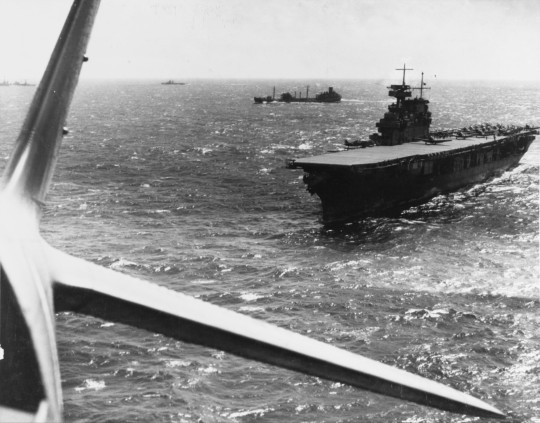
"USS YORKTOWN (CV-5) operating in the Pacific, photographed from a Douglas TBD-1 torpedo plane that has just taken off from her deck. Other TBD and SBD aircraft are also ready to be launched. A F4F-3 'Wildcat' fighter is parked on the outrigger just forward of the island. The other ships in the company include the fleet oiler USS GUADALUPE (AO-32), a destroyer and a heavy cruiser. This view has been retouched to censor the CXAM-radar antenna mounted atop Yorktown's foremast."
Date April 1942
U.S. Navy photo: 80-G-640553
#USS YORKTOWN (CV-5)#USS YORKTOWN#Yorktown Class#Aircraft Carrier#Warship#Ship#USS GUADALUPE (AO-32)#USS GUADALUPE#Oiler#United States Navy#U.S. Navy#US Navy#USN#Navy#World War II#World War 2#WWII#WW2#WWII History#History#Military History#Pacific Ocean#April#1942#my post
52 notes
·
View notes
Text

An employee of Douglas Aircraft Company works with electrical wiring at the plant in Long Beach, California. Credit Alfred T. Palmer.
42 notes
·
View notes
Text
Amestris Military Real world Influence
This is the third of my series of long posts about the Amestrian Military. This is the post for the history nerds. There are plenty of real world references in Fullmetal Alchemist, especially pertaining to the first half of the 20th century. While Amestris and its military have often been compared to Nazi Germany (especially when it comes to the anime), the references in the manga are very diverse. Disclaimer, this is by no means an exhaustive list, there are too many for me to cover in one post, and I'm not a historian. So let me know if there's any reference I might have missed or if I got something wrong!
To see the rest of this meta series check out the Main Post..
Names
Probably the easiest reference to the real world is in the names of the military personnel. Almost all of them are named after military vehicles and equipment, mainly from World War II. Some examples:
Roy Mustang — P-51 Mustang (USA WW2 aircraft)
Riza Hawkeye & Grumman — Northrop Hawkeye E-2 Grumman (USA 60s aircraft)
Maes Hughes — Hughes aircraft series (USA aircraft company)
Black Hayate — Nakajima Ki-84 Hayate (Japanese WW2 aircraft)
Jean Havoc & Henry Douglas— Douglas A-20 Havoc (USA WW2 aircraft)
Heymans Breda — Breda M37 (Italy WW2 Machine gun) or HMS Breda (UK WW2 Yacht)
Kain Fuery — Hawker Fury (UK 30s aircraft)
Vato Falman — Farman aircrafts series (French aircraft company)
Armstrong Family — Armstrong Whitworth Whitley (UK WW2 aircraft)
Weapons and equipment
The weapons used by the military are also based on real world weaponry. Arakawa herself admitted to using references for weapons as well as for the vehicles.[1] Not all of them are a direct copy of a historical weapon, but all of them are at least inspired by one or more of them.
Pistol — Colt M1911A1 (USA 1924)
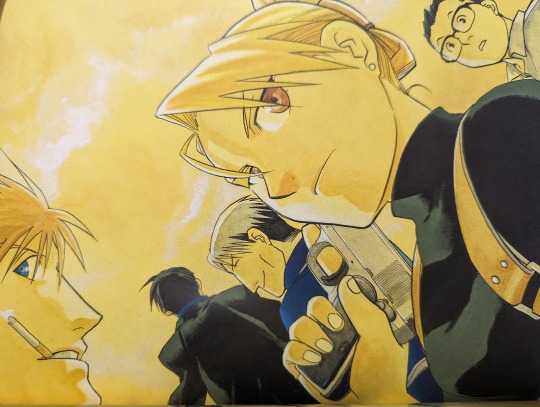
Hawkeye's pistol. [1]

Colt M1911 & M1911A
Rifle — Mauser Karabiner 98k (Germany WW2)

Hawkeye's Rifle. [1]

Mauser Karabiner 98k rifle
Hand grenade — Stielhandgranate M24 aka the potato mashers (Germany WW2)
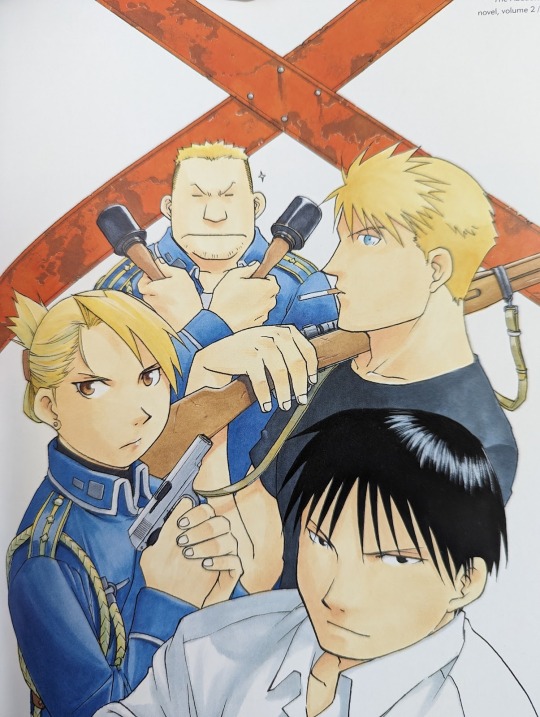
Team Mustang's and their weapons. [1]

Stielhandgranate M24
Briggs' Tank
The Briggs' tank isn’t modeled directly after any specific tank, and rather takes inspiration from different WW1 to WW2 tanks. The manga and Brotherhood tanks take after different inspirations, with Brotherhood being more German coded than the manga tank. There's an excellent article in the tanks encyclopedia analyzing the Fullmetal Alchemist tanks if anyone's interested.
Military Cars —
We see a few military cars throughout the story. Once again the cars we see in the manga and Brotherhood are quite different, and they appear to be based on models from the late 1910s to the late 1930s.
The manga’s standard issued military car looks at least partially inspired by the American Ford model A of 1927.

Mustang's military car(manga).[2]

1927 Ford model A.
The Brotherhood art sketches have two different drawings of military cars. The first one, the one we see Mustang use, is based on the French Citroën traction avant 11CV of 1935.

Fullmetal Alchemist Brotherhood military vehicle version 1.

1935 French Citroën traction avant 11CV.
The second car seems to be inspired by the Italian Fiat Tipo 5 of the 1910s. Perhaps even inspired by one of the American made Fiat models.

Fullmetal Alchemist Brotherhood military vehicle version 2.

Fiat tipo 55.
Ranks and insignias
With the exception of the Führer-President, the Amestrian military ranks appear to be a mix of the USA WW2 officer ranks:
General,
Lt. General,
Major General,
Brigadier General,
Colonel,
Lt. Colonel,
Major,
Captain,
1st Lieutenant,
2nd lieutenant;
As well as the Imperial Japan NCO ranks:
Warrant officer (Special Sergeant Major),
Master Sergeant,
Sergeant,
Corporal.
The history of the Imperial Japan Warrant Officer rank is a bit confusing and complicated. In the 79 years that the Empire lasted, the Warrant Officer rank saw a lot of changes, being its own category at times, a Senior NCO at others. The NCO Warrant Officers seem to have been specialized Sergeant Majors (also translated as Master Sergeant) that basically functioned as the most senior of the NCO ranks. Aside from this the one modern country, I could find, that has Warrant Officers as NCO is Malaysia.
The rank of Führer-President (大総統 - Daisōtō in Japanese) replaces the rank of General of the army in the USA officer classification. While the English translation is a direct reference to Nazi Germany, the Japanese word is a lot more nuanced.
The word Daisōtō actually refers to the president of the 1912-1924 Republic of China, and if you Google it, all you will get is images of Bradley himself. The term used for “Führer” is 総統 (Sōtō), without the 大 (Dai) which is instead used in the word president 大統領 (Daitōryō), this is probably the inspiration for the Führer-president title of the official English translation.
However, Sōtō isn't used to refer just to Nazi Germany's Führer, but rather to any fascist associated head of state. As such Germany's Sōtō is the Fuhrer, but Italy's Sōtō is the Duce (Mussolini).
The effect is technically the same (you still think of Hitler and fascism), but the Japanese word is not a direct translation of Führer, nor a direct reference to Nazi Germany, it's more subtle than the English translation. I imagine Führer was used in English (in absence of a more subtle unifying word) as it is more recognizable to the English speaker than other fascist titles like: Duce, Caudillo, Generalísimo, etc.
The WW2 imperial Japan ranks also included superior private, first class private, and second class private, but they were their own class, called soldiers, below the NCO ranks, and were mainly composed of men serving their conscripted time. This might explain their absence in the Amestrian official ranks as Amestris doesn't seem to have conscription.
The rank insignias themselves are pretty much a copy of the imperial Japan ones.
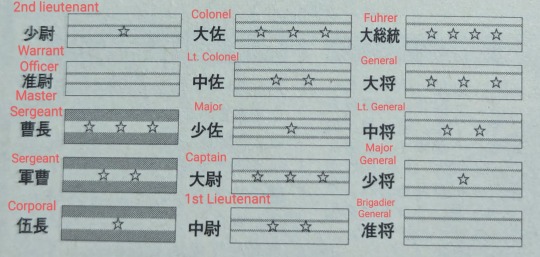
Amestris rank insignias.[3]
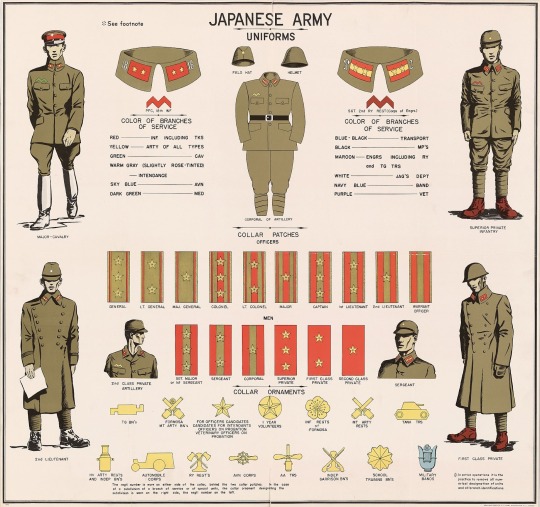
Imperial Japan ranks insignias.
Uniform
In terms of the uniform there's not one single reference or perfect match for the design, but the closest to it is probably the WW1 French infantry uniform.

Amestris military uniform. [1]
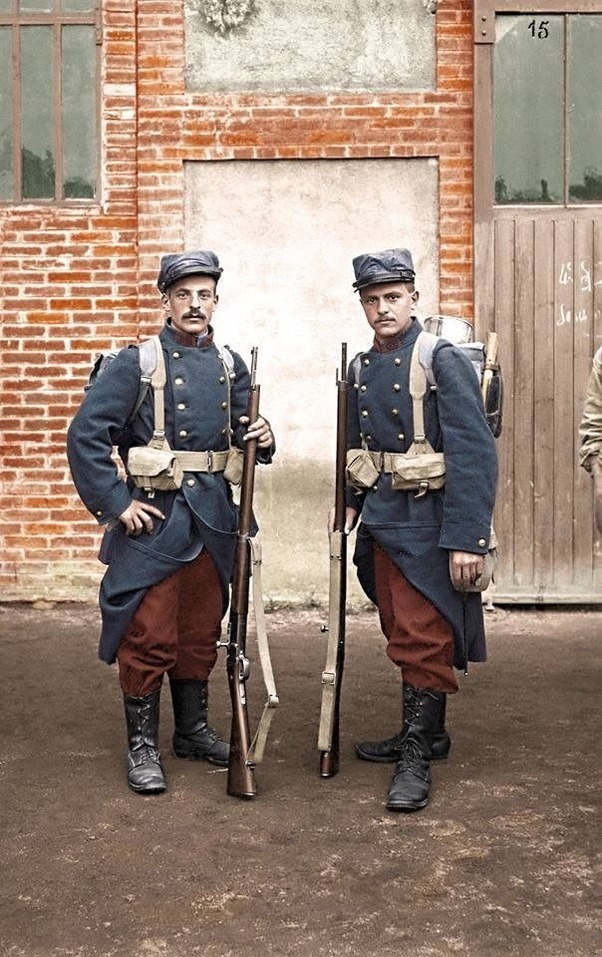
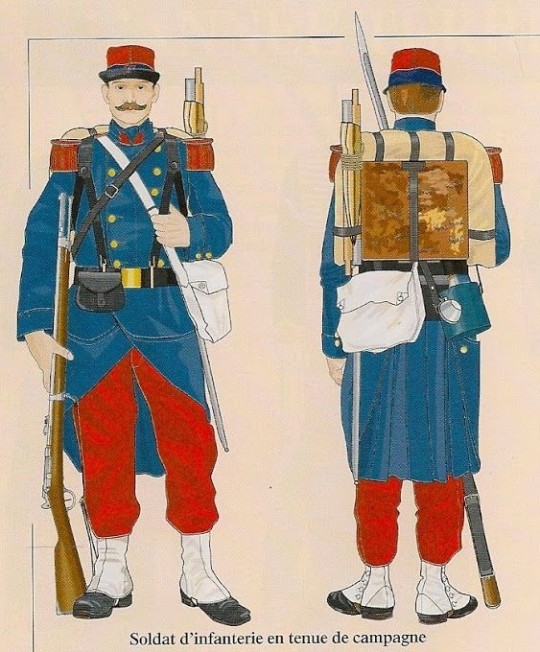
Early WW1 French uniform

Late WW1 French uniform
Aside from the color of the French uniform, the long skirt, flaps and boots are very similar to the Amestrian uniform.
The Amestrian short jacket itself seems to be inspired by the WW2 USA Ike jacket.

USA WW2 Ike jacket.
Furthermore the white lining of the Amestrian uniform reminds me of the Imperial Japan formal uniform jacket, which is itself Prussian and French inspired.
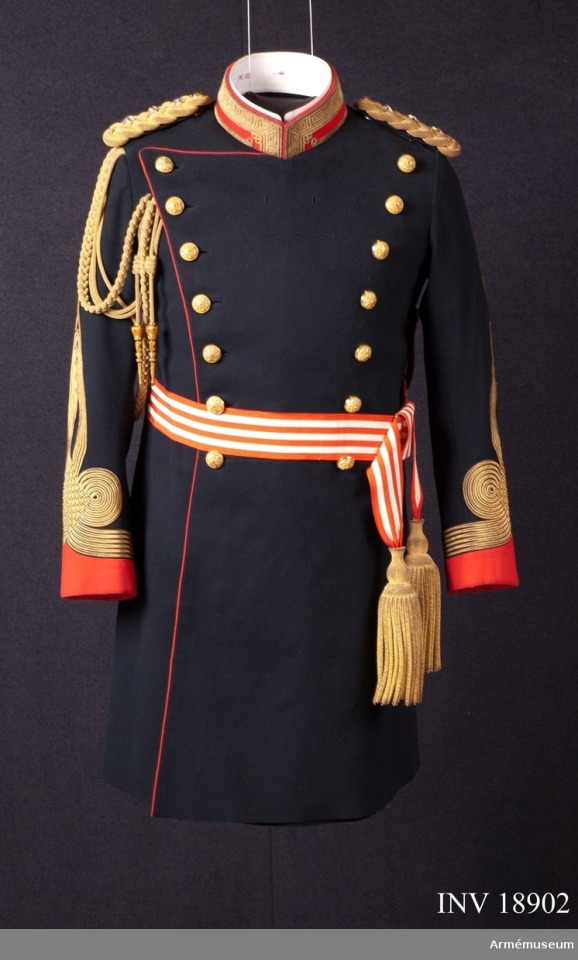
Imperial Japan Major General formal uniform.
The Briggs uniform is very much WWII winter gear inspired.

Briggs uniform.[3]
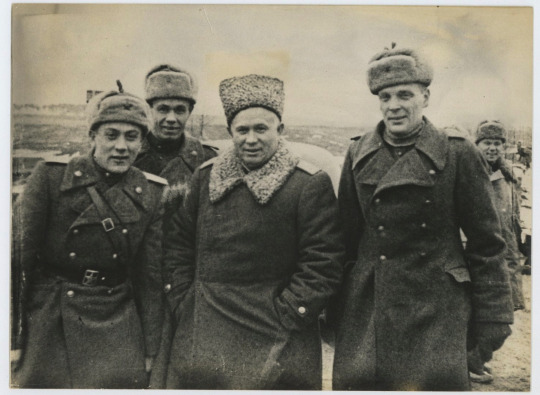
Soviet WW2 winter uniform

Finnish WWII sniper.
Out of every uniform variation, the one most German coded is, to no one's surprise, the Führer-president’s. His trench coat looks similar to the WW1 Prussian one.

Bradley in uniform.
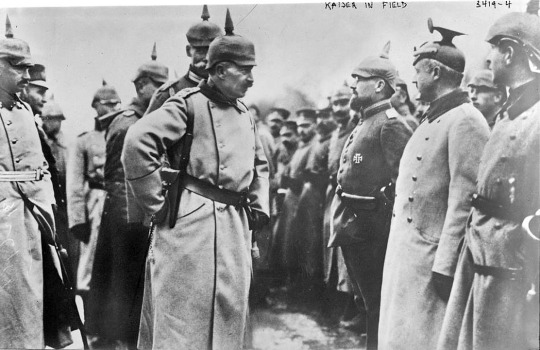
WW1 Prussian soldiers.
In general the uniform has a very World War I vibe to it, down to the impractical, decorative parts of it like the skirt. This is an uniform that obviously predates modern warfare, very apt for the time period the story is “set on”. This makes an interesting contrast with the weaponry which seem to be mostly World War II inspired.
Other references
Ishval war of extermination
First of all trigger warning for genocide and human experimentation. Just skip this section if you're sensible to these topics.
Just like the Ishvalan are an amalgamation of many cultures and ethnicity, the Ishvalan civil war seems to reference multiple conflicts and events.
Plenty of comparisons have been made with the Jewish genocide in the hands of the Nazi (and the 03 anime leans especially hard on this). There are also similarities with the Herero war and genocide at the hand of the German empire which just like the Ishval Civil war ended in 1908. Another possible reference is the Armenian genocide at the hands of the Ottoman empire, which also involved a minority living at the border of a nation the country was at war with and being suspected of colluding with the enemy. Both the Armenian and the Ishvalan soldiers serving in the army were dismissed, incarcerated, and eventually executed.
Another more clear cut reference made in the Ishval civil war is Mustang's and Knox’s experimentation. This would be a reference to the horrendous experiments done by both the Nazi and Japan's infamous unit 731. Both which included burning people to test treatments and the limits of the human body.
I am sorry to end up on such a hard note, but I think it's best we move on to other — less traumatic — topics.
Source
Fullmetal Alchemist Manga
Chapter 38: a counter attack signal [2]
The Complete art of Fullmetal Alchemist [1]
Fullmetal Alchemist perfect guide 3 [3]
Training Regime post
28 notes
·
View notes
Text

Worker at the Douglas Aircraft Company in Long Beach, California
October 1942
rayeshistory.com
13 notes
·
View notes
Text
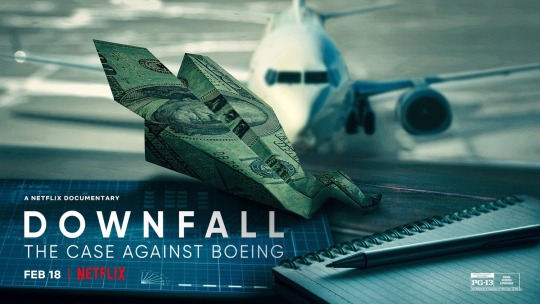
Finally watched the above movie. Highly recommend it if you want to understand why the newer versions of Boeing aircraft are unsafe. Specifically the 737 max series.
Spoiler and summary: Boeing was once a model of quality, safety and team emphasis to produce respected aircraft. In the late 90s they were bought out by McDonell Douglas and changed all that. Everything. Profit was first and foremost. Quality and safety suffered and was in fact discouraged, ignored and punished. The movie uses excellent interviews with those most involved in the entire process: the wife of the pilot who crashed in the first incident in 2018, many family members, engineers, congressional investigators, oversight pilots, and internal Boeing quality and safety technicians and inspectors. Most notable is John Barnett the whistleblower who was recently suicided. Movie was released in 2022 so his passing is not referenced but you quickly realize how articulate and trustworthy he was. In short a clear threat to Boeing. Here’s the long why explanation this is still important to current events :
Movie focuses on the two aircraft that crashed in 2018 and 2019 within the first 5 months of the aircraft being fielded. Blame game ensues naturally but facts come to light about Boeing that were not, and are not, portrayed fully accurately or completely in the media as usual because they are bought off and in on it. At least none that I could find after the movie to compare media accuracy to the movie. After much investigation and finger pointing by Boeing, and the FAA doing nothing, Boeing in 2021 eventually agreed to pay a fine of $2.5 Billion for criminal fraud to avoid a trial and further probe of criminal conspiracy. The agreement stipulates that if Boeing meets a series of requirements, the charge of criminal fraud will be dropped after three years…which would be 2024! Shocking eh? This avoids a potential criminal conviction of Boeing as a company. That’s important for Boeing as a key U.S. defense contractor; a conviction could have excluded it from future government contracts. BIG money. Unfathomable amounts. Globally. Now and in the future.
So Boeing execs clearly made multiple decisions that killed people and no one was held responsible. Even the “fall guy” CEO, Dennis Mullenburg who “resigned” or was fired by the board in 2019 received a severance package totally some $62 million.
BUT the movie just focuses on those two early crashes naturally, which manifested itself due to lack of quality and safety early in the planes tenure. ALL the other noteworthy stuff like the below that is just NOW manifesting is due to the same overall problem:

Of note the exact Boeing CEO names get muddled in all this but it’s one big happy party of negligence and shared guilt as usual, no matter who takes one for the team. Here’s the CEO/president names since the takeover in the 90s:

Mullenburg, while guilty, did not start the process. And the current CEO has stated he will step down this year. But they are all guilty.
The problems with the 737 Max series will continue to manifest for years to come. That’s why this is important.
Don’t forget this happened for a reason:


Also not further extrapolated in the movie was who was in charge of the do-nothing Dept of Transportation under which the do nothing FAA falls:
Elaine Chao. She was the meaningless mouthpiece for all of it at the federal level. Who is Chao married to:
Mitch “the turtle” McConnell.
Starting to see how everything is connected and everyone is guilty?
Highly rec the movie. Good luck traveling!

11 notes
·
View notes